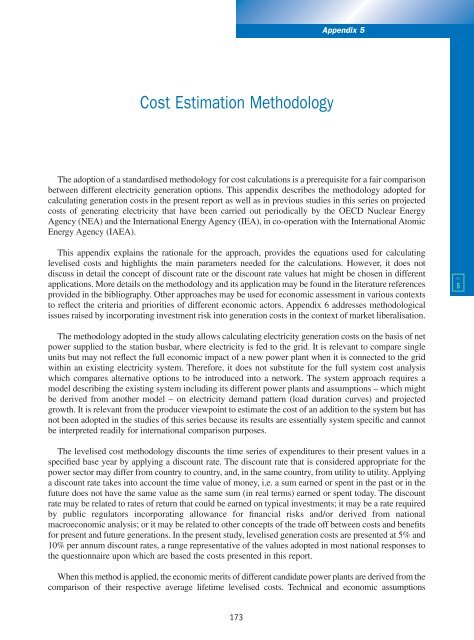Projected Costs of Generating Electricity - OECD Nuclear Energy ...
Projected Costs of Generating Electricity - OECD Nuclear Energy ...
Projected Costs of Generating Electricity - OECD Nuclear Energy ...
You also want an ePaper? Increase the reach of your titles
YUMPU automatically turns print PDFs into web optimized ePapers that Google loves.
Appendix 5<br />
Cost Estimation Methodology<br />
The adoption <strong>of</strong> a standardised methodology for cost calculations is a prerequisite for a fair comparison<br />
between different electricity generation options. This appendix describes the methodology adopted for<br />
calculating generation costs in the present report as well as in previous studies in this series on projected<br />
costs <strong>of</strong> generating electricity that have been carried out periodically by the <strong>OECD</strong> <strong>Nuclear</strong> <strong>Energy</strong><br />
Agency (NEA) and the International <strong>Energy</strong> Agency (IEA), in co-operation with the International Atomic<br />
<strong>Energy</strong> Agency (IAEA).<br />
This appendix explains the rationale for the approach, provides the equations used for calculating<br />
levelised costs and highlights the main parameters needed for the calculations. However, it does not<br />
discuss in detail the concept <strong>of</strong> discount rate or the discount rate values hat might be chosen in different<br />
applications. More details on the methodology and its application may be found in the literature references<br />
provided in the bibliography. Other approaches may be used for economic assessment in various contexts<br />
to reflect the criteria and priorities <strong>of</strong> different economic actors. Appendix 6 addresses methodological<br />
issues raised by incorporating investment risk into generation costs in the context <strong>of</strong> market liberalisation.<br />
App.<br />
5<br />
The methodology adopted in the study allows calculating electricity generation costs on the basis <strong>of</strong> net<br />
power supplied to the station busbar, where electricity is fed to the grid. It is relevant to compare single<br />
units but may not reflect the full economic impact <strong>of</strong> a new power plant when it is connected to the grid<br />
within an existing electricity system. Therefore, it does not substitute for the full system cost analysis<br />
which compares alternative options to be introduced into a network. The system approach requires a<br />
model describing the existing system including its different power plants and assumptions – which might<br />
be derived from another model – on electricity demand pattern (load duration curves) and projected<br />
growth. It is relevant from the producer viewpoint to estimate the cost <strong>of</strong> an addition to the system but has<br />
not been adopted in the studies <strong>of</strong> this series because its results are essentially system specific and cannot<br />
be interpreted readily for international comparison purposes.<br />
The levelised cost methodology discounts the time series <strong>of</strong> expenditures to their present values in a<br />
specified base year by applying a discount rate. The discount rate that is considered appropriate for the<br />
power sector may differ from country to country, and, in the same country, from utility to utility. Applying<br />
a discount rate takes into account the time value <strong>of</strong> money, i.e. a sum earned or spent in the past or in the<br />
future does not have the same value as the same sum (in real terms) earned or spent today. The discount<br />
rate may be related to rates <strong>of</strong> return that could be earned on typical investments; it may be a rate required<br />
by public regulators incorporating allowance for financial risks and/or derived from national<br />
macroeconomic analysis; or it may be related to other concepts <strong>of</strong> the trade <strong>of</strong>f between costs and benefits<br />
for present and future generations. In the present study, levelised generation costs are presented at 5% and<br />
10% per annum discount rates, a range representative <strong>of</strong> the values adopted in most national responses to<br />
the questionnaire upon which are based the costs presented in this report.<br />
When this method is applied, the economic merits <strong>of</strong> different candidate power plants are derived from the<br />
comparison <strong>of</strong> their respective average lifetime levelised costs. Technical and economic assumptions<br />
173

















